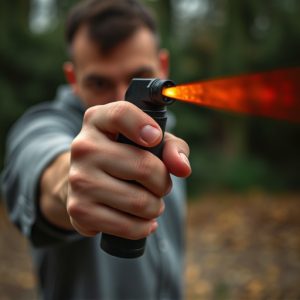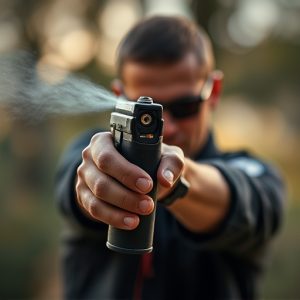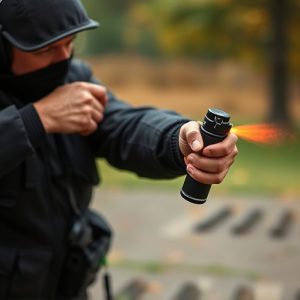OC Spray: Decoding Capsaicin Concentration for Effective Law Enforcement
OC spray, a non-lethal law enforcement tool, utilizes capsaicin from chili peppers in concentrations…….
OC spray, a non-lethal law enforcement tool, utilizes capsaicin from chili peppers in concentrations (1%-2%) that balance effectiveness and safety. Higher capsaicin levels (5%-10%+) enhance incapacitation but require specialized training. Law enforcement strategically selects these OC Spray Capsaicin Concentration Levels based on threats and operational needs, prioritizing responsible use to control suspects while minimizing harm to bystanders. Choosing the right spray involves considering concentration alongside spray pattern, distribution, and duration for optimal effectiveness in diverse scenarios.
“Uncovering the power of OC spray: a law enforcement essential. This comprehensive guide explores the world of pepper spray weapons, focusing on capsaicin concentration levels and their impact on effectiveness. From understanding the active ingredient to delving into safety protocols and comparing grade differences, we dissect what makes OC spray a crucial tool for officers. Discover how capsaicin concentration levels determine its potency, ensuring law enforcement personnel are equipped with the knowledge to make informed decisions in high-pressure situations.”
- Understanding OC Spray: A Comprehensive Overview
- Capsaicin Concentration: The Key to Pepper Spray's Effectiveness
- Law Enforcement Usage and Safety Protocols
- Comparing Different Grade Pepper Spray Weapons
Understanding OC Spray: A Comprehensive Overview
OC spray, short for Oleoresin Capsicum spray, is a non-lethal weapon widely used by law enforcement agencies worldwide. It works by deploying a powerful irritant, capsaicin, which is derived from chili peppers. This chemical agent causes temporary pain, blindness, and difficulty breathing when it comes into contact with the skin, eyes, or respiratory system. The effect lasts for several minutes, providing enough time for officers to subdue and control an individual.
The capsaicin concentration levels in OC spray vary, but typically range from 1% to 2%. This concentration is calculated as the weight of pure capsaicin per volume of the spray solution. Higher concentrations offer more intense effects, but they also require proper training for safe handling to prevent accidental self-injury or harm to bystanders. Understanding these capsaicin concentration levels is crucial in evaluating the effectiveness and potential risks associated with OC spray during law enforcement operations.
Capsaicin Concentration: The Key to Pepper Spray's Effectiveness
The effectiveness of pepper spray, or OC spray, lies in its capsaicin concentration.
Capsaicin is the chemical compound responsible for the burning sensation and discomfort associated with spicy foods and pepper spray. The concentration of capsaicin in pepper spray varies widely, typically measured in milligram per liter (mg/L) or parts per million (ppm). Lower concentrations, around 1-2% (10,000-20,000 ppm), may cause temporary eye irritation and coughing, while higher concentrations, ranging from 5-10% (50,000-100,000 ppm) or more, can incapacitate individuals for several minutes due to severe respiratory distress. Law enforcement agencies carefully consider capsaicin concentration levels based on the intended use scenario and target threats, balancing effectiveness with safety concerns.
Law Enforcement Usage and Safety Protocols
Law enforcement agencies worldwide have long relied on pepper spray as a non-lethal force option to control and subdue suspects. OC (oleoresin capsicum) spray, commonly known as pepper spray, contains capsaicin, a chemical derived from chili peppers. The effectiveness of pepper spray lies in its ability to irritate the eyes, nose, and respiratory system, temporarily disabling an individual. Law enforcement officers are trained to use this weapon strategically, focusing on specific body areas like the face and eyes to ensure minimal harm while neutralizing the threat.
Safety protocols govern the usage of pepper spray to protect both officers and bystanders. These include strict guidelines on the type and concentration of capsaicin used, typically ranging from 1% to 2%. Officers are taught to assess the situation, communicate their intentions clearly, and only deploy pepper spray as a last resort when other de-escalation methods fail. Proper training ensures that officers can handle the spray responsibly, minimizing its impact on innocent individuals and maintaining public safety during law enforcement operations.
Comparing Different Grade Pepper Spray Weapons
When comparing different grade pepper spray weapons, one key factor is the capsaicin concentration levels. OC (oleoresin capsicum) spray, for instance, varies in potency from 0.2% to 1.34% capsaicin. The higher the concentration, generally speaking, the more effective the spray will be in neutralizing an assailant. However, it’s crucial to consider that higher concentrations may also increase the likelihood of adverse reactions or off-target effects.
Different grade pepper sprays are designed for specific applications and environments. For example, military-grade pepper spray tends to have higher capsaicin levels and more robust features for extreme situations. In contrast, civilian-grade options focus on balance between potency, range, and safety. Additionally, factors like spray pattern, distribution, and duration of effects should be evaluated alongside capsaicin concentration to ensure the chosen weapon meets the user’s needs effectively and responsibly.
OC Spray, or capsaicin-based pepper spray, is a powerful tool in law enforcement’s arsenal. Understanding the capsaicin concentration levels and safety protocols is essential for effective and responsible usage. By comparing different grades of pepper spray weapons, officers can make informed decisions to ensure optimal performance and minimize risks. The right choice can significantly enhance their ability to maintain public safety while adhering to strict protocol standards.


